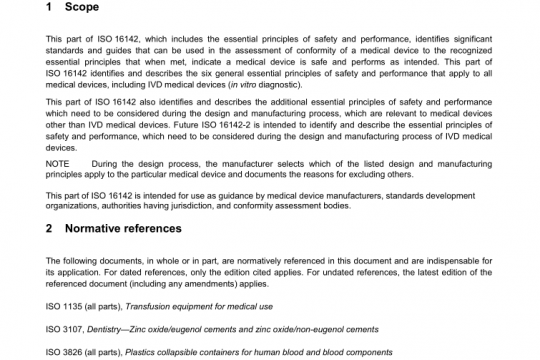AAMI ISO 10651-4 pdf free download
AAMI ISO 10651-4 pdf free download.Lung ventilators- -Part 4: Particular requirements for operator-powered resuscitators.
5.3 R) Patient valve function after contamination with vomitus
After the resuscitator has been tested in accordance with the test described in A.4.3, it shall meet the requirements specified in 6.2, 6.4, 6.7.1 and 6.7.2.
NOTE It is preferable that the valve housing be constructed so that operation of the mechanism can be observed by the operator, e.g. through a transparent housing. Observation of the functioning mechanism of the patient valve can assist the operator in detecting abnormal operation.
5.4 Mechanical shock
5.4.1 R) Drop test
The resuscitator shall meet, at room temperature, the requirements specified in 6.2, 6.4 and 6.7.1, following the drop test described in A.4.4.
5.5 Immersion in water
After immersion in water by the method described in A.4.5, the resuscitator shall comply with the requirements specified in 6.2, 6.4, 6.7.1 and 6.7.2.
5.6 R) Bag refill valves
Bag refill valves for use with resuscitators shall not have provision for manual operation.
5.7 Materials of construction
All gas conducting parts shall be from materials selected to take into account the chemical and physical properties of any substances that the manufacturer declares can be administered by the resuscitator
6 Ventilatory requirements
6.1 R) Supplementary oxygen and delivered oxygen concentration
When tested by the method described in A.4.6 in accordance with the requirements of its classification (see 6.7.1) a resuscitator shall provide a minimum delivered oxygen concentration of at least 35 % (VN) when connected to an oxygen source supplying not more than 15 1/mm and, in addition, shall be capable of providing an oxygen concentration of at least 85 % (VIV) (see note). The manufacturer shall state the range of delivered oxygen concentrations at representative flows, i.e. 2 1/mm, 4 1/mm, 6 1/mm, 8 1/mm, etc.
NOTE The 85 % (VN) requirement can be accomplished with the use of an attachment.
6.2 R) Expiratory resistance
In the absence of positive end-expiratory pressure devices, and when tested by the method described in A.4.7, the pressure generated at the patient connection port shall not exceed 0,5 kPa ( 5 cmH2O). (See also 10.2 c) 8)).
6.3 R) Inspiratory resistance
When tested by the method described in A.4.8, the pressure at the patient connection port shall not exceed 0,5 kPa ( 5 cmH2O) below atmospheric pressure. (See also 10.2 C) 8)).
6.4 R) Patient valve malfunction
When tested by the method described in A.4.9, an inadvertent positive expiratory pressure greater than 0,6 kPa ( 6 cmH2O) shall not be created at an added input flow of up to 30 1/mm when this flow is added in accordance with the manufacturer’s instructions.
6.5 R) Patient valve leakage -Forward leakage
If forward leakage is a design feature, it shall be so stated in the instruction manuaL.
6.6 R) Resuscitator deadspace and rebreathing
When tested by the method described in A.4.10, the resuscitator deadspace shall not exceed 5 ml + 10 % of the minimal delivered volume specified for the classification of the resuscitator (see 6.7.1).
Excessive rebreathing should not occur during spontaneous breathing.
6.7 R) Ventilation performance
6.7.1 R) Minimum delivered volume (VdeI)
When tested as described in A.4.1 1 using the compliance, resistance, frequency and l:E ratio given in Table 1, the minimum delivered volume shall be as given in Table 1.
6.7.2 R) Pressure limitation
6.7.2.1 For resuscitators designated for use with a body mass less than 10 kg, a pressure-limiting system shall be provided so that the airway pressure does not exceed 4,5 kPa ( 45 cmH2O) under the test conditions described in A.4.1 2. However, it shall be possible to generate an airway pressure of at least 3 kPa ( 30 cm H20).
NOTE An override mechanism can be provided.AAMI ISO 10651-4 pdf download.
Other IEC Standards
-

ANSI AAMI ISO 16142-1 pdf free download – non-IVD medical devices and guidance on the selection of standards
AAMI standards list DOWNLOAD -

ANSI AAMI ISO 16142-2 pdf free download – General essential principles and additional specifc essential principles
AAMI standards list DOWNLOAD


